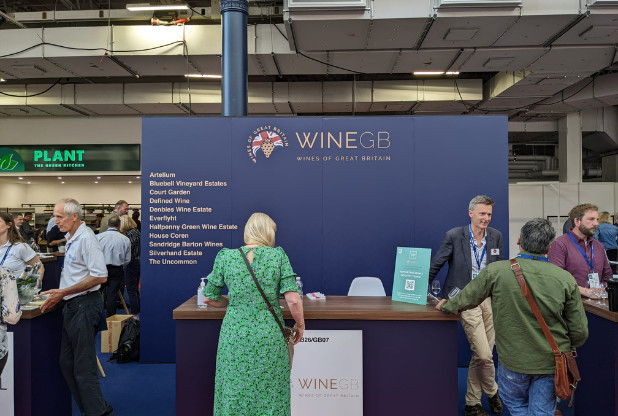
Still wines to the fore at WineGB stall
From Georgia to Greece, to China and Uruguay, the 2023 London Wine Fair (LWF) has showcased many esoteric regions across its vast trade floor. As its home event, it may seem odd to place UK wines in this ‘emerging’ bracket. However, with little penetration beyond a simmering domestic market, the wines of Great Britain are hardly a global phenomenon… yet.
This is the current state of play in the UK: there are 3,758 ha under vine in England and Wales, with 879 vineyards and 197 wineries (195 in England, two in Wales).
Hectarage has more than doubled in just eight years and quadrupled since the turn of the millennium, coinciding with the UK’s ten warmest years on record, which have all occurred since 2002.
With ripeness at an all-time high, surely climate change is a net-win for the UK wine industry?
“The obvious answer would be yes,” said William Coren, CEO and founder of House Coren.
He added: “It’s warmer, the grapes are riper, all of that stuff. But when you sort of delve into it, the weather patterns they are showing are becoming more and more unpredictable which, for a vineyard, is a nightmare. So on the one hand, climate change is making winegrowing in this country more viable, but, on the other, it’s also making it more difficult.”
Coren continued: “For instance, this year has been incredibly wet so far, we weren’t able to get the tractors out to use our nutritional spray, so our disease risk went up which potentially reduces your yields.”
With a more favourable climate, what’s stopping UK wines from hitting the mainstream? Are we likely to see homegrown fizz in ice buckets up and down the country any time soon?
Ben Hunt, winemaker for Halfpenny Green said: “Price points are hard to get down when vineyards are cropping lower, and wineries aren’t big scale. It’s hard to compete with bigger wineries with larger plots and bigger contracts.”
Emma Hodges, wine and trade sales, Artelium added: “I think the bottle labelling could be better, consumers want to know what they are getting for their money, it’s about educating customers. For example, we are about to release a Chardonnay blend and it’s got something like 13% Pinot Gris in it – legally we don’t have to declare that on the label but we will because it’s really important for people when they are tasting the wine to know exactly what’s in it.”
She continued: “It might be easier and less confusing to label it as simply a 'Chardonnay', but we think it’s important that a consumer knows exactly what they are getting so they can make a more informed decision at the point of purchase.”
In a post-Covid world, consumers are more interested in homegrown products, therefore, when faced with an English still wine that costs more than European equivalents, the brand communication must be spot on.
The emergence of English sparkling in recent years has certainly infiltrated the retail sector, with most supermarkets boasting own-label options in this category. Still wines, on the other hand, are less common. However, with warmer summers on the horizon, the UK may well be in a position to grow Southern European grapes in the future.
Ben Hunt from Halfpenny Green said: “A lot of English vineyards are riding on Bachuus, Solaris is the other upcoming one – its tropical, ripeness levels can get 13-14% sometimes.”
He added: “There are already vineyards planting Sauvignon Blanc, Pinot Grigio, people are trying Grenache at a really low level and Gamay, so there’s definitely potential in the long-term. There’s also talk about Riesling slowly coming into the country as well, but that could be a few decades away.”
The Artelium stand at LWF proudly announced its first-ever Pinot Noir, which is being bottled as we speak, courtesy of the hot 2022 summer.
Emma Hodges said: “The 2022 vintage was really good, they're just being bottled at the moment, so we’ve got Chardonnay, Pinot Noir and Rose again. This was our first year producing Pinot Noir because the weather was so hot.”
She added: “In 10 years' time, I think our still wine production will mainly consist of Chardonnay and Pinot Gris.”
Asked whether the wines were market or terroir-driven Hodges responded: “It’s about what the vineyard is offering us, it’s about what we do well with it rather than what the general public wants.”
Therefore, it’s up to the UK wineries to dictate what UK consumers want, through great-tasting wine and a penetrating market strategy.
The price point remains an issue for customers, but the excitement and appetite are certainly there, and the WineGB stall boasts some of the most intriguing wines at LWF.






